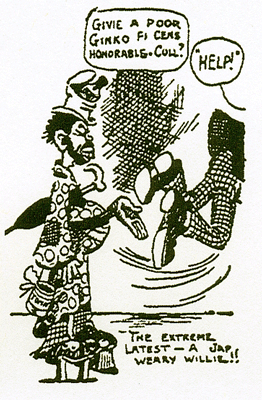
October 9, 1907
Los Angeles
Where now we fret over every Mexican and Saudi, uh, Iraqi who crosses our border, time was, we fretted over the Japanese. And rightfully so—they are studious and upright, and therefore cunning. Oh, wait, that was the stereotype concocted after 1941. In 1907, they were all hungry railroad tramps.
You will I trust forgive me while I quote liberally from the original text:
“Sound the alarm…the Japs have scaled the last wall of our complicated civilization. Having learned how to work, they are now starting in on the science of learning how not to work—invading Vagobondia. In fact the first crop of oriental Happy Hooligans was reaped yesterday morning.”
M. Mitsuz and R. Moresons traveled from Japan to Mexico in search of work. They worked Down South for a spell, “but for some queer reason got an inspiration to go with a trainload of Jap emigrants to Vancouver, where Japs get clumped around by the natives.”
The two aforementioned gentlemen were piled into a cheap day coach, and were “transported over more miles than they thought were on the globe.” Having made the journey from Japan, this writer feels that to be, likely, highly inaccurate. In any event, there was apparently no food on the train, as Mitsuz, “who is about the size of a pickled onion, murmured in his dreams the names of luscious Jap dishes that made his pal, Moresons, groan aloud. When the train passed any place where there were restaurants, their two little noses twitched and sniffed like rabbits.” Again, without there having been a reporter on the train with them, we can only marvel at the describatory liberties taken herein. But such was the deft and trenchant reporting of the time.
With dame hunger having taken hold, though while under bond and legally not allowed to leave the train, Mitsuz and Moresons beat it out of the railroad yards and into the nearest eatery: “They had their first introduction to their ‘ham an,’’ and somebody scooped out for them a restaurant pie resembling two clam shells, with a piece of felt hat for filling. They devourered it and suffered grievous things in their tummies during the night. Japanese nightmares, having all those crawly things you see shinning up the sides of rose vases for literary material, must be something fierce.”
That may be so. (I invite those readers of Japanese ancestry to confirm and clarify.)
While at the beanery, where our duo “ate until their skins were spread thin,” the train up and left without them, taking all of their belongings with. They ran around for a while, making “rag-time” gestures at officials, who dutifully ignored them. They climbed into a boxcar hoping to hop a freight north, but were pinched by railyard bulls, who “rounded them into the station with the regular grist of Weary Willies and tomato can bums.”
Messrs. Mitsuz and Moresons face deportation.






